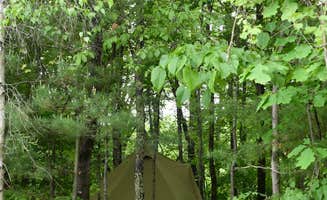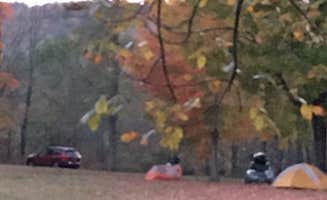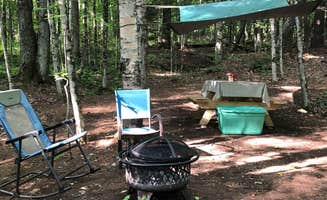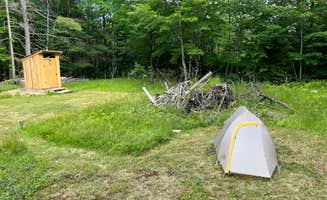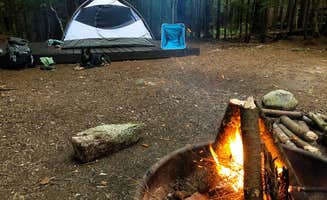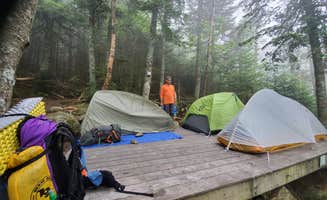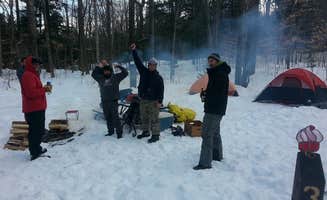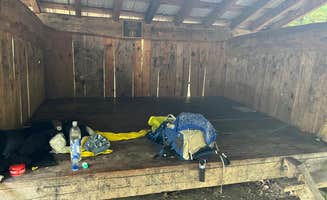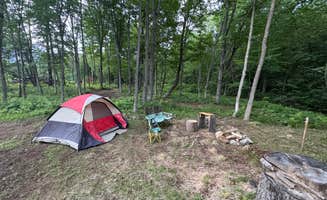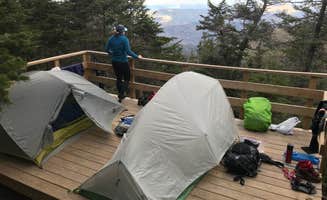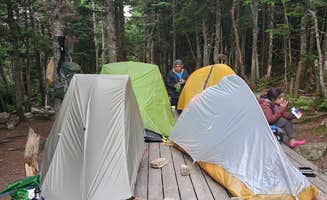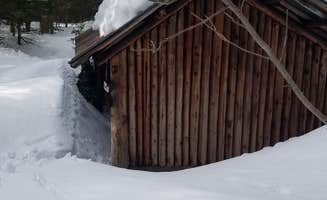Tent campsites near Ashland, New Hampshire sit within easy reach of the White Mountains region, offering varied terrain from riverside spots to elevated mountain settings. Most sites experience typical New England weather patterns with summer highs around 80°F and winter temperatures frequently below freezing. The camping season runs primarily from May through October, though some backcountry sites remain accessible year-round for winter camping enthusiasts.
What to do
Hiking to scenic viewpoints: Baker Rocks campsites provide convenient access to nearby trails. "The property and individual sites are deliberately designed with guests in mind," notes Justin P., who appreciated the camp's proximity to fishing spots and hiking routes.
Rock climbing adventures: AAC Rattlesnake Campground serves as a perfect basecamp for climbers. "Maintained by the American Alpine Club, pretty much all the campers here are rock climbers," explains Les R., highlighting the campground's specialized focus.
Winter snowshoeing: Fourth Iron Campground offers year-round access for cold-weather explorers. Ryan M. shares, "Can be very secluded in winter months, sometimes you're the only person there," making it ideal for those seeking solitude during off-season camping trips near Ashland.
Paddling and fishing: Many camping areas provide river access with clear, cold water perfect for summer recreation. The Saco River near Fourth Iron Campground features "multiple rocky beaches in between the sites and river" according to Sarah C., who found the "water is clear and cold, refreshing on a warm day."
What campers like
Private wooded sites: At Baker Rocks, campers appreciate the layout and natural setting. "The tent sites are within the wooded area around the property and felt very secluded," writes Justin P., who enjoyed the privacy despite noting "a bit of road noise overnight."
Well-designed platforms: Many tent campsites near Ashland feature raised platforms that keep tents dry. April W. mentions Baker Rocks' accommodations are "spacious and wonderful, among tall trees and pines," providing comfort even during rainy conditions.
Easy-access backcountry: Sawyer Pond offers a gentle introduction to remote camping. Hunter P. describes it as "a 1.5 mile walk from the parking lot to the campsite and pretty easy. It is mostly flat with a few minor hills (I saw children and elderly folks easily using this trail)."
Natural water features: Jean C. appreciated Fourth Iron Campground's setting, noting "This year-round campground is a short walk from the road and situated along the river, providing nice swimming/wading when the weather is right."
What you should know
Bear safety requirements: Most camping areas near Ashland require proper food storage. Sarah C. mentions that at Rogers Ledge, "You do have to forage for firewood, which can be rough," and campers should "glance up before you decide where to pitch your tent" due to dead trees.
Seasonal considerations: Site accessibility varies throughout the year. According to Jean C., "Check the White Mountain National Forest website for information about road openings in the spring and fall" when planning trips to Sawyer Pond, as approaches may be affected by seasonal road closures.
Limited facilities: Most tent sites offer basic amenities only. At Paugus Brook Farm, Justin P. found "The outhouse is brand new and super clean and right nearby, though there are no picnic tables and fires aren't permitted due to area fire restrictions."
Weekend crowds: Popular sites fill quickly, especially during peak season. Sarah C. advises Sawyer Pond visitors to "Have a back-up plan for an alternate camping location," after witnessing "several parties, many with young children, arriving late to find that all the sites were occupied."
Tips for camping with families
Short hiking options: Paugus Brook Farm offers field camping with easy access for families. Justin P. notes it's "a very short walk from the designated parking area" with "fairly level ground and lots of space," making it manageable for children.
Animal encounters: Some campgrounds feature wildlife viewing opportunities. April W. mentions Baker Rocks even has "animals to visit like bunnies and goats (far away from the campsites)," which can be entertaining for children.
Water-based recreation: Riverside camping spots provide natural play areas. Zach P. simply calls Fourth Iron "Nice beautiful area by the river," where families can enjoy wading and exploration.
Beginner backpacking routes: Jean C. shares that Sawyer Pond "was my introduction to backpacking more than 40 years ago" and notes "Either approach, but particularly the one from Sawyer River Rd, is family friendly."
Tips from RVers
Tent-only locations: Most campgrounds near Ashland cater primarily to tent campers. Squam Lakes Association sites are described by Shari G. as "Simple, but gorgeous. The association maintains about a dozen campsites in the Squam Lake area -- some hike-in and others boat-in only."
Non-RV alternatives: When RVs aren't suitable, many locations offer platform tents or yurts. Justin P. observed Baker Rocks had "a host of different camping options onsite including tent platforms, yurts, and cabins," providing alternatives for those without tents.
Limited hookups: Campers seeking traditional RV amenities should look elsewhere. Jen S. emphasizes that Squam Lakes Association is ideal for those who "prefer tent camping and like to be secluded; we are not into RV parks."


